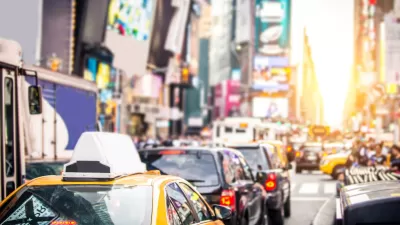Edward L. Glaeser looks back on the boom towns of yore and warns that, without a little balance, the dominance of finance in New York could spell trouble.
For a city of over 8 million people, an astonishing portion of New York's wealth is earned in just one, curiously abstract place: financial services. Concentrated predominantly in Manhattan, the financial industry accounted for 44 percent of all wages earned in the borough in 2008. With that level of economic concentration, Glaeser cautions, New York may expose itself to the kind of vulnerability that hollowed out the manufacturing-heavy cities of the Rust Belt – Detroit, Cleveland, and Pittsburgh, to name a few.
Of course, it wasn't always this way. Even with its earlier cash cows – first sugar refining, then printing and publishing, and finally garment manufacture – the city always kept economically diverse. At the height of the garment industry's success, right around 1950, it employed only 8 percent of all New Yorkers. Weighing in at only 16 percent of total employment in Manhattan, Glaeser notes that the financial sector may not seem as dominant at first blush. "Still, the sheer size of the financiers' salaries means that the success of other industries, from the restaurant business to real estate, is tied closely to the success of finance."
Glaeser likens the circa-1970s innovations in the financial market to Henry Ford's transformation of industry at the turn of the century, attributing "the troubled city's resurgence" to "quantitative approaches to evaluating risk, ever-larger leveraged buyouts, [and] the securitization revolution."
There are ample theoretical arguments on both sides of the aisle, arguing either that concentrating an industry in one tight space catalyzes the production of knowledge, or that innovation founders in the absence of diversity. "At its extreme, this [latter] view predicts that Silicon Valley will eventually resemble Detroit. In the short run, industrial concentration can lead to rapid leaps along a technological path. But progress along that path will eventually grow slower and yield diminishing returns, since an industrial monoculture will not encourage radically new discoveries."
But what can the city do to steer the economy in the right direction? Glaeser doesn't advocate stifling finance, but rather removing the hurdles that stand in the way of budding enterprise. In particular, he points to controlling property values and income taxes, both of which can be onerous to innovators in promising-but-risky fields like applied science.
"Building on a long, narrow island will always be expensive, but it could be less expensive if there were fewer rules deterring new construction. The city is currently considering 'upzoning' the area around Grand Central Terminal to allow bigger, denser buildings, which could slow price growth for the financial-sector firms located there. Increasing the supply of top-tier space for financiers would indirectly aid other sectors as well, by limiting the competition for less prime real estate elsewhere in New York."
FULL STORY: Wall Street Isn’t Enough

Alabama: Trump Terminates Settlements for Black Communities Harmed By Raw Sewage
Trump deemed the landmark civil rights agreement “illegal DEI and environmental justice policy.”

Planetizen Federal Action Tracker
A weekly monitor of how Trump’s orders and actions are impacting planners and planning in America.

The 120 Year Old Tiny Home Villages That Sheltered San Francisco’s Earthquake Refugees
More than a century ago, San Francisco mobilized to house thousands of residents displaced by the 1906 earthquake. Could their strategy offer a model for the present?

Ken Jennings Launches Transit Web Series
The Jeopardy champ wants you to ride public transit.

BLM To Rescind Public Lands Rule
The change will downgrade conservation, once again putting federal land at risk for mining and other extractive uses.

Indy Neighborhood Group Builds Temporary Multi-Use Path
Community members, aided in part by funding from the city, repurposed a vehicle lane to create a protected bike and pedestrian path for the summer season.
Urban Design for Planners 1: Software Tools
This six-course series explores essential urban design concepts using open source software and equips planners with the tools they need to participate fully in the urban design process.
Planning for Universal Design
Learn the tools for implementing Universal Design in planning regulations.
Clanton & Associates, Inc.
Jessamine County Fiscal Court
Institute for Housing and Urban Development Studies (IHS)
City of Grandview
Harvard GSD Executive Education
Toledo-Lucas County Plan Commissions
Salt Lake City
NYU Wagner Graduate School of Public Service





























